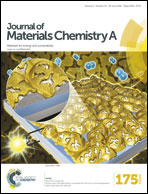A H5BW12O40–polyvinyl alcohol polymer electrolyte and its application in solid supercapacitors
Abstract
A polymer electrolyte comprised of H5BW12O40 (BWA) and cross-linked polyvinyl alcohol (BWA–XLPVA) has been developed and characterized for solid supercapacitors. The performance of this polymer electrolyte was compared to that of a known polymer electrolyte based on H4SiW12O40 (SiWA). An enhanced proton conductivity was observed for BWA–XLPVA compared to its SiWA counterpart, especially under low humidity conditions (5% RH). Dielectric analyses revealed an increase of proton density and proton mobility in the BWA-based electrolyte. A solid-state 1H NMR study showed that all protons in the BWA-based electrolyte were hydrated in the low humidity environment. This indicated that BWA had more crystallized water content than SiWA, resulting in higher proton mobility in the PVA matrix. An in situ tracking of electrode potential in solid supercapacitors was utilized to identify the reactions and the factors limiting solid supercapacitor cell voltage for both BWA- and SiWA-based polymer electrolyte systems. A solid device leveraging the BWA-based polymer electrolyte achieved a cell voltage of 1.3 V, 0.2 V wider than that of a SiWA-based device.


 Please wait while we load your content...
Please wait while we load your content...